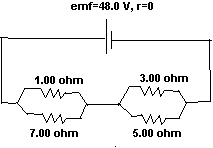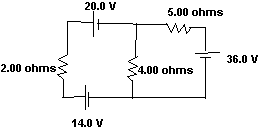
Workshop module 6 - Physics 114, Spring 2000
1:
In which 120-V light bulb does the filament have the greater resistance … a 60-Watt bulb or a 120-Watt bulb? If the two bulbs are connected to a 120-V line in series, across which bulb will there be the greater voltage drop? What if they are connected in parallel?2: Calculate the equivalent resistance of the network shown below and find the current in each resistor. The battery has negligible internal resistance.

3: Electric rays (genus Torpedo) can deliver electric shocks to stun their prey and to discourage predators. The voltage is produced by thin, wafer-like cells called electrocytes, each of which acts as a battery with an emf of about 10-4 V. Stacks of electrocytes are arranged syde-by-side on the underside of Torpedo. In such a stack, the positive face of each electrocyte touches the negative face of the next electrocyte. What is the advantage of stacking the electrocytes? Of having the stacks side by side? (This is Q27-10 in the text. You can find pictures illustrating the problem on page 855.)
4: Find the current through each of the three resistors of the circuit below. The emf sources have negligible internal resistance.

5: When a capacitor, battery and resistor are connected in series, does the resistor affect the maximum charge stored on the capacitor? Why or why not? What purpose does the resistor serve?
6: A resistor with R=86.0 kW is connected to the plates of a charged capacitor with capacitance C=4.5 m F. Just before the connection is made, the charge on the capacitor is 0.0636 C. What is the energy initially stored in the capacitor? What is the electrical power dissipated in the resistor just after the connection is made? What is the electrical power dissipated in the resistor at the instant when the energy stored in the capacitor has decreased to half the initial value?